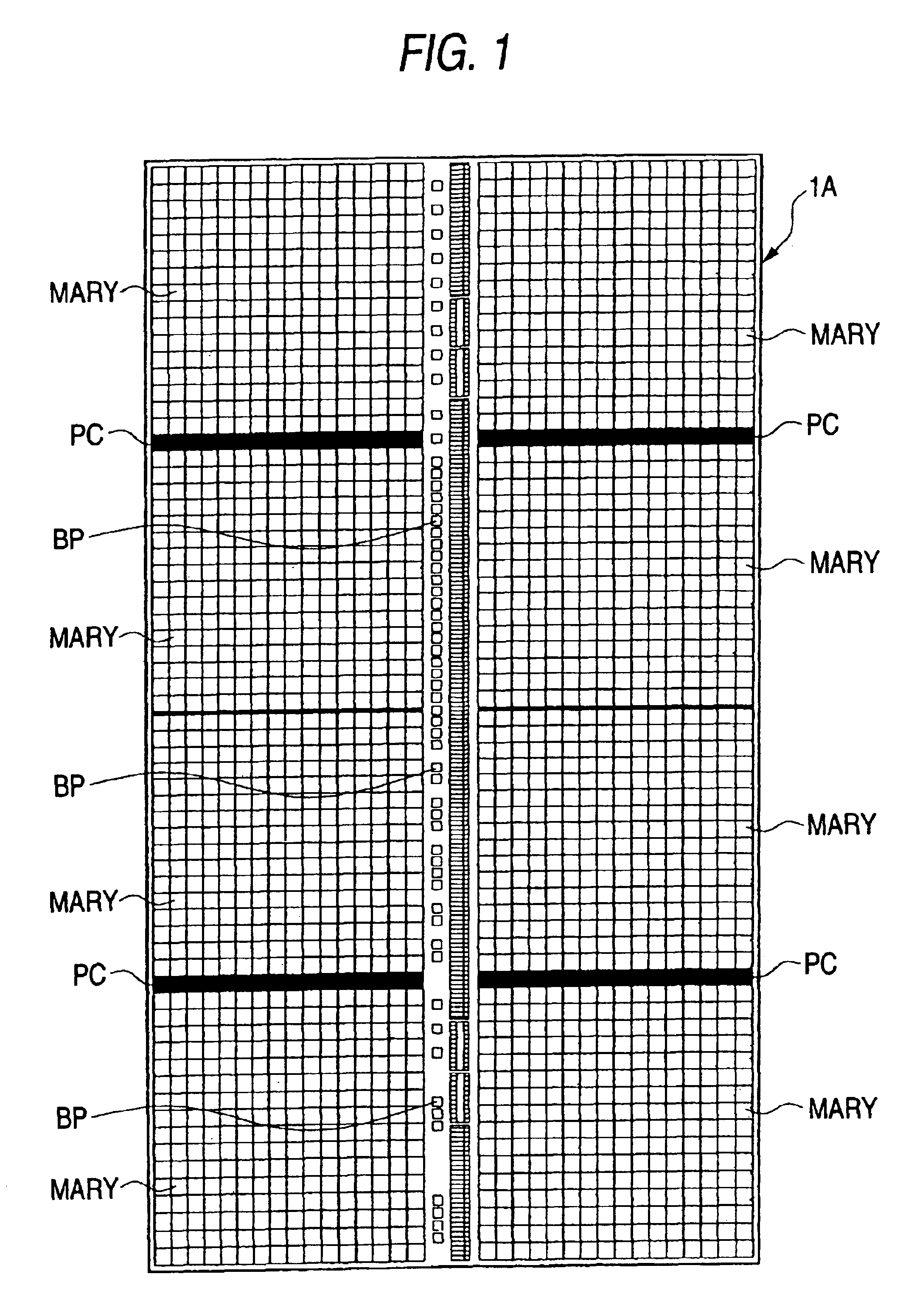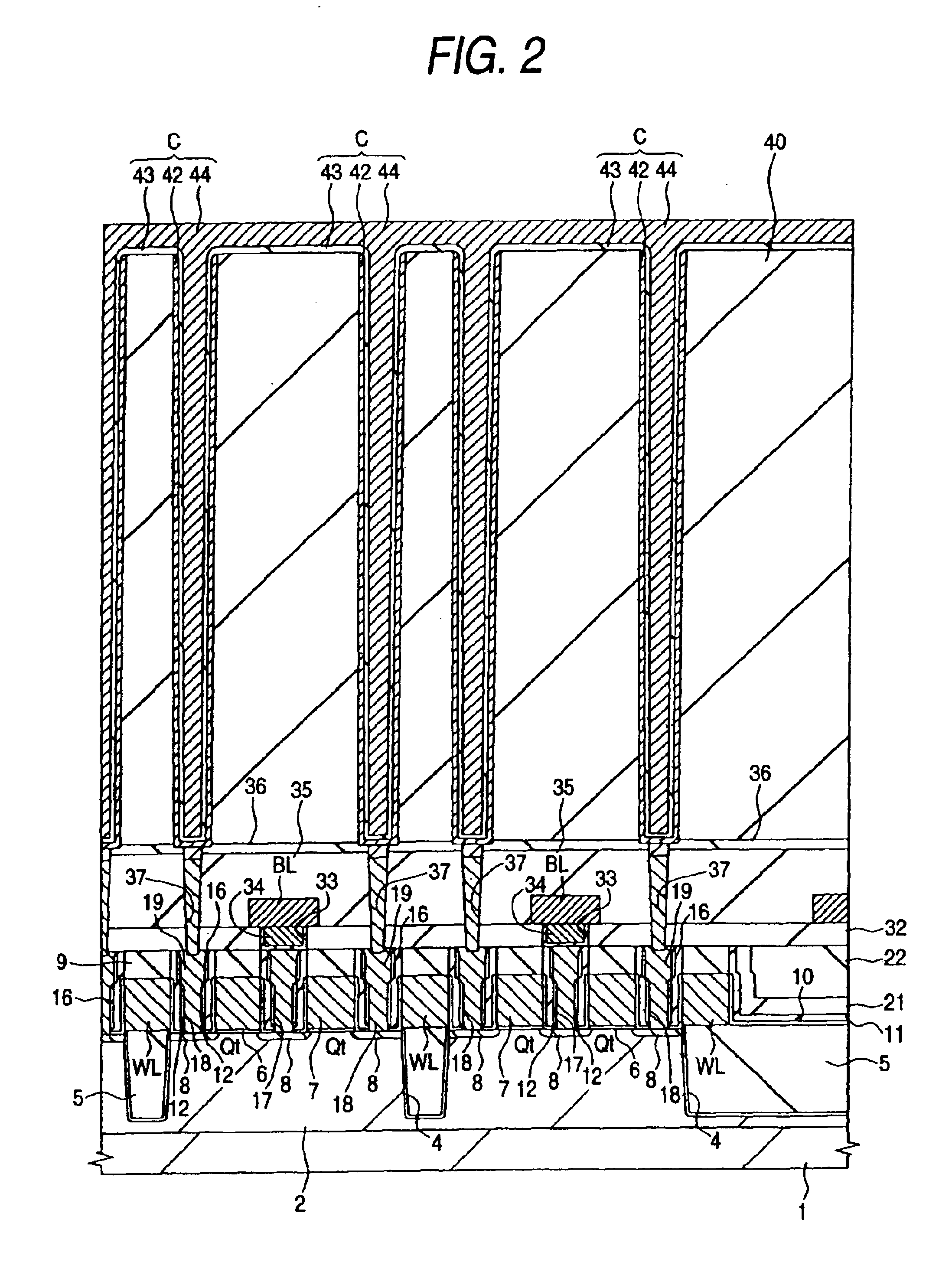Method of producing a semiconductor integrated circuit device and the semiconductor integrated circuit device
a technology of integrated circuits and semiconductors, applied in semiconductor devices, semiconductor/solid-state device details, electrical apparatus, etc., can solve the problems of preventing the cutting of substrates, causing voids to be generated in silicon oxide films, and causing short circuits in adjacent contact holes
- Summary
- Abstract
- Description
- Claims
- Application Information
AI Technical Summary
Benefits of technology
Problems solved by technology
Method used
Image
Examples
embodiment 1
[0121]FIG. 1 depicts a whole plan view illustrating a semiconductor chip 1A formed with a DRAM (Dynamic Random Access Memory) of
[0122]On a main surface of the rectangular semiconductor chip 1A is formed a DRAM having 256 Mbits of storage capacity, for example. This DRAM has a storage part comprised of a plurality of memory arrays (MARY) and a peripheral circuit part PC disposed therearound. Additionally, in the center part of the semiconductor chip 1A, a plurality of bonding pads BP to which a wire or bump electrode is connected are arranged in a row.
[0123]FIG. 2 depicts a section of a principal part of a semiconductor substrate illustrating one end part of the storage part described above.
[0124]For example, or the main surface of the semiconductor substrate 1 comprised of p-type single crystal silicon are formed a p-type well 2, and or the p-type well 2 is formed a device isolation trench 4. On an active region of the p-type well 2 whose periphery is defined by the device isolation...
embodiment 2
[0187]Next, the method for fabricating the DRAM of the embodiment 2 will be described in accordance with FIGS. 60 to 65.
[0188]The method for fabricating the DRAM of the embodiment 2 is the same until the processes described with reference to FIGS. 3 to 21 in the embodiment 1.
[0189]After that, as shown in FIGS. 60 and 61, the insulating film 11 in the bottom of the hole parts 13 and 14 is removed by anisotropic etching (dry etching). At this time, a mixed gas of CHF3 and O2 is used as an etching gas to increase the etching selective ratio of the insulating film 11 comprised of the silicon nitride film with respect to the insulating film 10 comprised of the silicon oxide film. Consequently, the insulating film 11 in the bottom of the hole parts 13 and 14 can be etched, using the insulating film 10 as an etching stopper.
[0190]As described above, the insulating film 11 in the bottom of the hole parts 13 and 14 can be etched using the insulating film 10 as an etching stopper. Thereby, th...
embodiment 3
[0198]Next, the method for fabricating the DRAM of the embodiment 3 will be described in accordance with FIGS. 66 to 73.
[0199]The method for fabricating the DRAM of the embodiment 3 is the same until the processes described with reference to FIGS. 3 to 23 in the embodiment 1 or the processes described with reference to FIGS. 60 to 65 in the embodiment 2. However, a deposited amount of the silicon nitride film configuring the insulating film 11 (third insulating film) is set about 10 nm.
[0200]Then, as shown in FIGS. 66 to 69 or 70 to 73, a silicon oxide film having a film thickness not completely burying the space between the gate electrodes 7 (word lines WL) is deposited over the semiconductor substrate 1 including the inside of the hole parts 13 and 14 to form an insulating film 12A (fifth insulating film). In the embodiment 3, the insulating film 12A is formed by CVD and the film thickness thereof can be formed to be about 30 nm, for example. The silicon oxide film configuring the...
PUM
 Login to View More
Login to View More Abstract
Description
Claims
Application Information
 Login to View More
Login to View More - R&D
- Intellectual Property
- Life Sciences
- Materials
- Tech Scout
- Unparalleled Data Quality
- Higher Quality Content
- 60% Fewer Hallucinations
Browse by: Latest US Patents, China's latest patents, Technical Efficacy Thesaurus, Application Domain, Technology Topic, Popular Technical Reports.
© 2025 PatSnap. All rights reserved.Legal|Privacy policy|Modern Slavery Act Transparency Statement|Sitemap|About US| Contact US: help@patsnap.com



